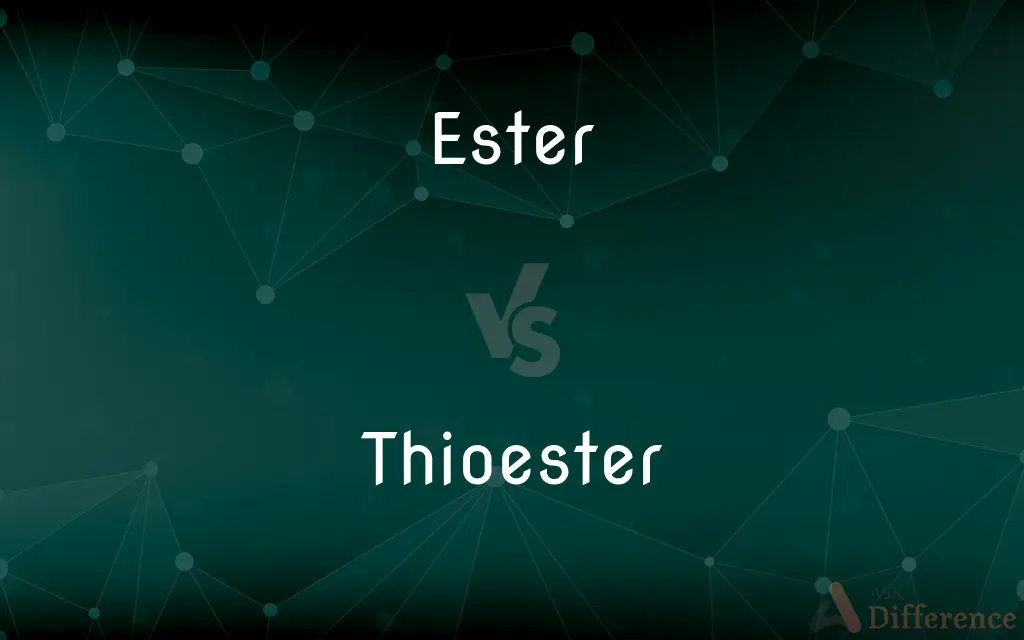Ester vs. Thioester — What's the Difference?
By Tayyaba Rehman — Updated on September 27, 2023
An "Ester" is an organic compound derived from acids, characterized by a COO group, while a "Thioester" is similar but contains a COS group instead.

Difference Between Ester and Thioester
Table of Contents
ADVERTISEMENT
Key Differences
Esters are organic compounds that are typically derived from carboxylic acids and alcohols. The functional group in esters is a carbonyl adjacent to an ether linkage, often represented as COO. This group gives esters their characteristic properties, including their often pleasant odors, which make them popular in fragrances and flavorings.
Thioesters, on the other hand, are also organic compounds but are derived from the substitution of an oxygen atom in the ester linkage with a sulfur atom. This results in a COS group. The inclusion of sulfur in thioesters gives them distinct chemical properties compared to esters. For instance, thioesters are more reactive than esters, which is significant in biological systems, especially in energy production processes.
When comparing ester and thioester at a structural level, the primary distinction is the presence of oxygen in esters and sulfur in thioesters. This single atom difference leads to varied reactivity and applications for each compound class. For example, while esters find use in everyday products like fragrances, thioesters are crucial in biochemistry, notably in the formation of acetyl-CoA.
In essence, while both esters and thioesters are important classes of organic compounds, they are differentiated by their structural makeup and the subsequent implications of this structure on their properties and uses. The presence or absence of sulfur, as opposed to oxygen, in the molecule plays a pivotal role in determining these characteristics.
Comparison Chart
Functional Group
COO (carbonyl + ether)
COS (carbonyl + thioether)
ADVERTISEMENT
Origin Atom
Oxygen
Sulfur
Reactivity
Generally less reactive
More reactive
Usage
Fragrances, flavorings
Biochemical processes
Structure
Derived from acids
Oxygen replaced with sulfur
Compare with Definitions
Ester
Known for their pleasant odors
Many perfumes contain Esters due to their fragrant properties.
Thioester
An organic compound similar to ester but with sulfur
Acetyl-CoA is a vital Thioester in metabolism.
Ester
An organic compound from carboxylic acids
Methyl acetate is a common Ester.
Thioester
Contains a carbonyl adjacent to a thioether
Thioesters have a distinct COS functional group.
Ester
Common in fragrances and flavorings
The fruity scent in some products is due to the presence of Esters.
Thioester
Formed by replacing ester's oxygen with sulfur
Thioesters are essentially Esters with a sulfur twist.
Ester
Contains a carbonyl adjacent to an ether
Esters are often recognized by their COO group.
Thioester
Significant in biochemistry
Thioesters play a pivotal role in energy transfer within cells.
Ester
Formed from acid and alcohol reaction
When acetic acid reacts with methanol, an Ester is produced.
Thioester
More reactive than typical esters
Due to the sulfur, Thioesters participate readily in biochemical reactions.
Ester
An ester is a chemical compound derived from an acid (organic or inorganic) in which at least one –OH hydroxyl group is replaced by an –O– alkyl (alkoxy) group, as in the substitution reaction of a carboxylic acid and an alcohol. Glycerides are fatty acid esters of glycerol; they are important in biology, being one of the main classes of lipids and comprising the bulk of animal fats and vegetable oils.
Thioester
In chemistry thioesters are compounds with the functional group R–S–CO–R'. They are analogous to carboxylate esters with the sulfur in the thioester playing the role of the linking oxygen in the carboxylate ester.
Ester
Any of a class of compounds derived from an oxyacid, usually resulting from the reaction of an oxyacid and an alcohol with the elimination of water.
Thioester
(organic chemistry) Any of several classes of organic compound in which one or both oxygen atoms of an ester group are replaced by those of sulfur
Ester
(organic compound) A compound most often formed by the condensation of an alcohol and an acid, with elimination of water, which contains the functional group carbon-oxygen double bond (i.e., carbonyl) joined via carbon to another oxygen atom.
Ester
An ethereal salt, or compound ether, consisting of an organic radical united with the residue of any oxygen acid, organic or inorganic; thus the natural fats are esters of glycerin and the fatty acids, oleic, etc.
Ester
Formed by reaction between an acid and an alcohol with elimination of water
Common Curiosities
Why are Thioesters crucial in biochemistry?
Thioesters, like Acetyl-CoA, play key roles in metabolic processes.
How are Esters typically synthesized?
Esters are commonly formed by the reaction of an acid with an alcohol.
Are Esters always fragrant?
Many Esters have pleasant odors, but not all.
Can Esters be found in natural sources?
Yes, many Esters occur naturally in fruits and flowers.
Are Thioesters stable compounds?
Thioesters are less stable compared to Esters due to their higher reactivity.
Which is more reactive, Ester or Thioester?
Thioesters are generally more reactive than Esters.
Are Thioesters common in commercial products like Esters?
No, Thioesters are more relevant in biological systems than in commercial products.
Can Esters be used as solvents?
Yes, some Esters serve as solvents in various applications.
Do Esters and Thioesters have the same functional group?
No, Esters have a COO group, while Thioesters have a COS group.
What happens when an Ester is hydrolyzed?
An Ester, upon hydrolysis, yields an alcohol and a carboxylic acid.
Can Esters be synthesized from Thioesters?
Yes, by replacing the sulfur atom in Thioesters with oxygen, Esters can be formed.
Why is the COS group in Thioesters significant?
The COS group imparts unique reactivity to Thioesters, making them crucial in certain biochemical pathways.
How do Esters and Thioesters differ structurally?
Esters contain an oxygen atom in the functional group, while Thioesters contain a sulfur atom.
Are Thioesters found in nature?
Yes, Thioesters like Acetyl-CoA are essential components in natural metabolic processes.
Are Esters polar compounds?
Yes, due to the carbonyl group, Esters are polar.
Share Your Discovery

Previous Comparison
Maisonette vs. Tenement
Next Comparison
Boo vs. BoAuthor Spotlight
Written by
Tayyaba RehmanTayyaba Rehman is a distinguished writer, currently serving as a primary contributor to askdifference.com. As a researcher in semantics and etymology, Tayyaba's passion for the complexity of languages and their distinctions has found a perfect home on the platform. Tayyaba delves into the intricacies of language, distinguishing between commonly confused words and phrases, thereby providing clarity for readers worldwide.














































